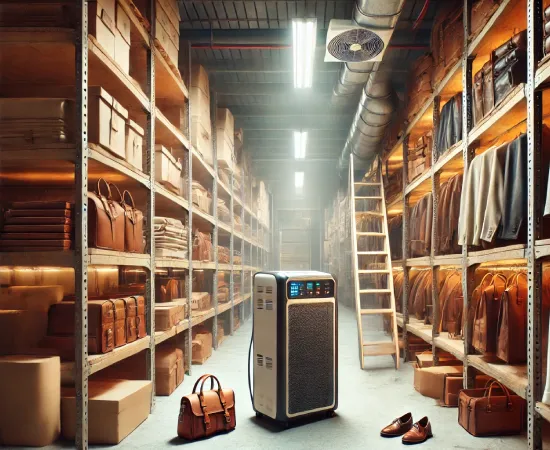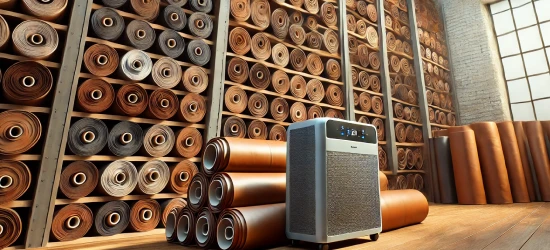When it comes to leather, wetness is undoubtedly its worst foe. Leather is highly hygroscopic, meaning it absorbs moisture from the air throughout the manufacturing process. Excessive moisture promotes the growth of germs like fungi and bacteria, leading to leather breakdown and damage. Especially during the leather tanning process, maintaining controlled humidity levels is essential to prevent quality issues and ensure a smooth finish. As a dehumidifier product and solution provider, we offer specialized dehumidifier solutions for the leather industry to tackle these challenges effectively.
Once leather products are ready for sale, they must be stored in a humidity-controlled environment to protect leather from moisture damage and preserve their durability and shine. In humid regions like Bangladesh, a reliable leather industry dehumidifier is indispensable. By keeping the relative humidity below 40%, these dehumidifiers safeguard leather products at every stage, from manufacturing to storage. As a leading leather industry dehumidifier provider, we ensure that leather goods remain in optimal condition, helping you maintain their quality for the long term.

Humidity plays a vital role in the leather manufacturing process. Leather is highly sensitive to moisture, and excessive humidity can cause serious issues such as warping, cracking, and a loss of overall quality. Without proper humidity control for leather manufacturing, the leather’s texture and appearance can degrade, making it difficult to maintain high standards for leather products.
Excess moisture in the air also promotes the growth of mold and bacteria, especially during the tanning and curing process. This not only damages the leather but can also result in costly production delays and product defects. To avoid these issues, the importance of dehumidifier in leather industry cannot be overstated. Implementing a dehumidifier solution provider for leather industry ensures that moisture is effectively managed throughout production, preventing moisture-related damage and maintaining the leather’s integrity.
To achieve the best results, it’s essential to choose the best dehumidifier for leather factories. These machines are specifically designed to maintain optimal conditions for leather drying and humidity control, enhancing the quality, appearance, and durability of the final product. By ensuring that the humidity levels are carefully regulated, leather manufacturers can produce superior products that meet both industry standards and customer expectations.

Dehumidifiers play a critical role in the leather industry by maintaining optimal humidity levels, preventing damage to leather products, and enhancing quality. By controlling moisture, dehumidification ensures leather items are free from defects such as warping, cracking, and mold growth. With the right dehumidification solutions for leather production, manufacturers can protect leather from moisture damage and extend the lifespan of their products.
By maintaining the proper humidity levels during the leather manufacturing process, dehumidification helps prevent product stagnation, sticking, and material fusion. This ensures superior quality leather goods and prevents hygroscopic materials from compromising the final product. As a leather industry dehumidifier supplier, we provide reliable solutions that enhance the overall product quality.
Condensation in leather manufacturing areas, especially in cold rooms or places with high humidity, can lead to moisture damage and equipment malfunctions. By using industrial dehumidifiers, manufacturers can prevent condensation, thereby protecting leather products and equipment from unnecessary wear and tear. Dehumidification solutions for leather production effectively eliminate this risk.
Leather products are often created in warm, humid, and poorly ventilated environments, making them prone to mold and bacteria growth. Dehumidification technology for tanneries plays a critical role in reducing the risk of contamination, ensuring that leather products are free from fungal and bacterial issues. This helps extend the lifespan of leather products, keeping them in optimal condition throughout their lifecycle.
In this mode, a single fan is used to handle both process and reactivation airflows. This configuration ensures maximum heat recovery, as shown in the airflow diagram. The system is designed for simplicity in installation while achieving the lowest possible dew point, making it highly efficient for moisture control.
This is the most common mode of operation and is designed to provide highly effective air drying. It can reduce the relative humidity (RH) to near 0%, ensuring a thoroughly dehumidified environment. This mode is ideal for applications requiring precise moisture control.
In this mode, heat recovery plays a key role in the reactivation process. The desiccant wheel absorbs heat during regeneration, allowing the reactivation air to be pre-heated and partially dehumidified before entering the reactivation area. This process improves energy efficiency and ensures effective moisture removal.
At our company, we understand the challenges faced by the leather industry when it comes to humidity control. Leather, while incredibly durable and often used in high-wear applications, is highly sensitive to fluctuations in ambient humidity during the tanning process. Variations in humidity can significantly affect leather’s tensile strength, making it either more flexible or prone to breakage. This longstanding issue makes it essential to maintain optimal humidity levels throughout the manufacturing process to ensure the leather has the right softness or strength for its intended use. Notably, humidity has a greater impact on chrome-tanned leather than on vegetable-tanned leather, making precise moisture control even more critical.
As a trusted leather industry dehumidifier supplier, we provide the best dehumidifier for leather industry applications. Our solutions are designed to help you maintain the perfect balance of moisture for superior leather quality. Whether you’re a manufacturer or tanner, our dehumidifier for leather industry ensures that your products are consistently of the highest standard. Choose us as your reliable leather industry dehumidifier provider, and experience enhanced leather durability, superior moisture control, and improved production efficiency.
Excess moisture can cause leather to warp, crack, or develop mold. Proper humidity control ensures the leather maintains its quality throughout the manufacturing process.
A dehumidifier reduces excess moisture in the air, preventing leather from absorbing too much humidity, which can compromise its texture, color, and durability during tanning.
The best dehumidifiers for leather factories are those designed specifically for large-scale industrial use, offering powerful moisture control and high efficiency to maintain optimal conditions for leather production.
Yes, using a dehumidifier in a leather factory or storage space helps keep humidity levels below 40%, preventing moisture-related issues such as mold and degradation of leather quality.
Choose a dehumidifier based on the size of your facility, the level of moisture in your area, and the specific requirements of your production process. Industrial-grade dehumidifiers with consistent performance are recommended.
Dehumidification extends the lifespan of leather by maintaining its texture, preventing damage from mold or bacteria, and ensuring a smooth, high-quality finish.
Absolutely. In humid areas, a dehumidifier is crucial to protect leather from excessive moisture, maintaining quality and preventing potential damage throughout production and storage.
Implementing dehumidifiers during drying and storage stages can help manage moisture levels, ensuring leather dries evenly without developing cracks or other issues caused by fluctuating humidity.
Dehumidification technology in tanneries helps to control the air moisture, preventing bacterial growth, ensuring smooth leather texture, and improving the overall quality of the final product.
